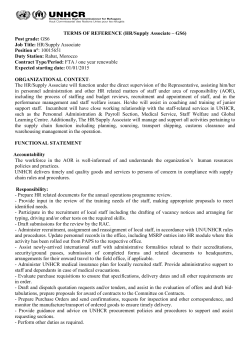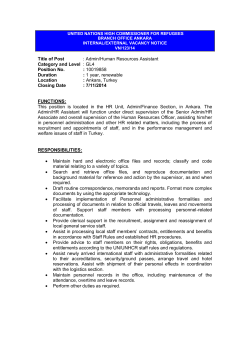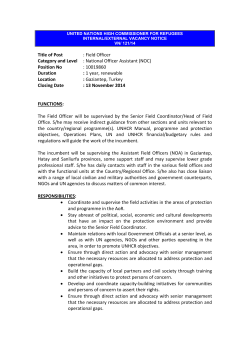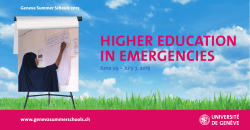
HIGHLIGHTS - Populations
UKRAINE SITUATION UNHCR OPERATIONAL UPDATE 6 – 20 March 2015 KEY FIGURES 1,152,000 d HIGHLIGHTS registered Internally Displaced People (IDPs) comprising: 694,000 pensioners 263,000 working age adults 147,000 children 48,000 disabled Situational overview: The number of displaced has stabilized with the reduction in the intensity of the fighting. Concerns have increased over mines and unexploded ordnance as people come out of basement and shelters. Economic difficulties continue to impact the population affected and host communities, with considerable price rises in recent weeks, especially in non-government controlled areas where there are shortages. Protection concerns: The Temporary Order on Movement, requiring those who wish to enter or leave the conflict area to obtain a permit, continues to present a significant obstacle to freedom of movement. The permit is not easy to acquire. Legislation update: The amended Cabinet of Ministers Resolution No. 509 on IDP registration, which introduced a mechanism for verifying current IDP addresses by the State Migration Service, came into force on 19 March and may lead to some IDPs losing their status and benefits. Assistance provided: Since 6 March UNHCR distributed aid to more than 10,200 people in government-controlled areas of Donetsk, Luhansk and Kharkiv regions. A further 2,000 people received UNHCR aid in non-government controlled areas of Donetsk region. Source: Ministry of Social Policy, Ukraine FUNDING USD 41.5 million requested for the operation in 2015 PRIORITIES As part of the UN Strategic Response Plan, to lead protection, shelter and NFI clusters to help those forcibly displaced from their homes. Support Government in efforts to establish a central authority to deal with IDPs. Work with the Government to improve registration system, specifically procedures relating to pensioners and access to social assistance. “I’m 65,” Galina says. “And everything I have, I’m holding.” Galina's two bags contain aid and all the belongings that remain from her destroyed home in Nikishyne, a small town in eastern Ukraine. Nikishyne is a shell, a town blasted by conflict. It was home to 900 people before the fighting started, but then found itself on the front line for more than six months. Now little is left intact. Many like Galina came back to survey their former homes in the first days after the ceasefire was negotiated in February. Photo: UNHCR/A. McConnell 1 UNHCR Operational Update-Ukraine UPDATE ON ACHIEVEMENTS Operational Context The reporting period has seen a continued reduction in the intensity of the fighting in eastern Ukraine and a consequent stabilization in the number of IDPs leaving the conflict area. Though in spite of the 12 February ceasefire, there have been continued exchanges of small arms fire and isolated incidents of shelling along the line of contact, particularly in the area of northern Donetsk. Elsewhere, the situation remains tense. As of 16 March there were a total of 1,152,000 IDPs registered by the Ministry of Social Policy, representing an increase of 52,000 since 2 March. This indicates a broadly constant number of new IDP registrations since the end of January, with latest weekly figures showing a decrease in the number of new registrations. The lull in fighting and improved weather has permitted movement in and out of the conflict area; people are no longer obliged to stay in shelters and basements, though many remain as they have nowhere else to go. Concern is now turning to demining and dealing with unexploded ordnance (UXO), with authorities in the conflict area declaring the issue a top priority. In many areas, homes and infrastructure have been seriously damaged and can only be repaired once UXO has been cleared. The presence of UXO and widespread destruction in former conflict areas could prevent people returning to their homes even if the conflict situation improves. UNHCR has begun conducting missions to non-government controlled areas of Luhansk region. Meetings were held with senior officials of the Luhansk People’s Republic (LPR) who welcomed the UN, assuring that all necessary support will be provided to ensure safety and security to permit the smooth delivery of humanitarian aid. This is an important development as UNHCR does not yet have a permanent presence in the area. Missions will continue until a permanent presence can be established. Since the ceasefire UNHCR and other humanitarian agencies have faced problems when attempting to deliver humanitarian aid to non-government controlled areas. Trucks carrying aid often face extensive delays or are refused permission to cross the line of contact at government checkpoints. This represents an issue of concern to the humanitarian community in Ukraine trying to bring assistance to civilians in non-government controlled areas. The Temporary Order on Movement, requiring those who wish to enter or leave the conflict area to obtain a permit, continues to pose a major protection concern and presents a significant obstacle to freedom of movement. The pass is not easy to acquire. Applicants must travel to issuing points close to the line of contact make their request. The issuing process can be lengthy with reports of some applicants waiting up to several months to obtain a pass. The system is also rife with corruption, with applicants often paying bribes to expedite the process. The State Border Guard Service reported that from 25 March the paper version of the pass would be discontinued and would be replaced by an electronic system. UNHCR will continue to monitor developments closely. External Displacement UNHCR continues to monitor the refugee situation in neighbouring countries. According to government sources in receiving countries, the total number of externally displaced people in neighbouring countries now stands at 695,180, with the majority going to the Russian Federation (611,000) and Belarus (80,880). A UNHCR assessment mission visited the Rostov region of the Russian Federation bordering Ukraine on 16-17 March. OSCE observers at Gukovo and Donetsk checkpoints on the Russia-Ukraine border reported seeing many Ukrainians return from Russia since mid-February, with “hundreds” of returns each day. Local authorities and OSCE officials suggest that the number of returnees may further increase provided the 12 February ceasefire holds. As of 19 March, there were 2,990 applications for international protection in Poland, 190 in Moldova, 50 in Romania, 50 in Hungary and 20 in Slovakia according to government sources in receiving countries. Data sources: Respective national asylum authorities United Nations High Commissioner for Refugees (UNHCR) – www.unhcr.org 2 UNHCR Operational Update-Ukraine Achievements Protection1 Protection Cluster The Protection Cluster, co-led by UNHCR and OHCHR, identified a number of concerns relating to IDP registration, including government plans to verify registered IDP addresses. Address verification could reduce the number of registered IDPs by 20-30 per cent, as many IDPs registered with temporary addresses. On 25 March, the cluster will hold a round table discussion on IDP registration to prepare a response. Protection and Shelter Clusters drafted a joint advocacy note on IDP housing, land and property issues in response to non-adoption by the Government of regulations implementing provisions on housing in the Law on IDPs. The Government is providing housing solutions to only 3 to 5 per cent of IDPs in temporary collective centers. UNHCR Implementing Partner, Crimea SOS, organized a round table entitled “Establishing Dialogue between the IDPs and the host community”. Participants considered protection, social integration, stigmatization, discrimination of IDPs from minority groups and IDP participation related issues. The Protection Cluster and Education Cluster, led by UNICEF, developed a joint plan addressing the issue of access to the final high school examination by students in non-government controlled areas. Beyond the immediate problem of the examination is the need to bring Government and Anti-Government Element (AGE) authorities together to work on a solution. Achievements, Impact and Identified Needs The amended Cabinet of Ministers Resolution No. 509 on IDP registration, which introduced a mechanism for the verification of current IDP addresses by the State Migration Service, came into force on 19 March. Non-confirmation of addresses will lead to the closure of IDP files in the government database and cancellation of IDP certificates by the Ministry of Social policy. UNHCR protection partners are closely monitoring the implementation of the verification. It is estimated by the Government that 20 to 30 percent of IDP registrations may be closed as a result. UNHCR continued its advocacy work with the Ministry of Social Policy to improve IDP registration in eastern Ukraine, discussing challenges faced by regional authorities as well areas of progress. The Deputy Minister of Social Policy informed that the Ministry has requested the Cabinet of Ministers for an extension beyond the initial 6 months of targeted financial support for IDPs under Resolution No. 505. Only working IDPs or those registered at employment centers would be eligible for the monthly UAH442 payment. The Ministry proposed a budget of more than UAH 2 billion for this purpose. On 16 March, UNHCR launched the first two-day Participatory Assessment Workshop in Dnipropetrovsk. Representatives of local authorities, NGOs and OCHA participated with a view to holding Participatory Assessments with IDPs to gather accurate information on specific protection risks faced by IDPs, underlying causes and to hear their proposed solutions. Participatory Assessment Workshops and exercises will also be conducted in Kharkiv, Severodonetsk, Mariupol and Donetsk. Shelter and Non Food Items (NFIs) Emergency Shelter and NFIs Cluster The Emergency Shelter and Non Food Items Cluster led by UNHCR is currently carrying out Post-Distribution Monitoring Analysis of cash assistance distributed in 2014 by UNHCR and four Cluster partners: ADRA, CARITAS, IOM and People in Need. So far over 5,000 beneficiary families have been interviewed and information related to income, expenditures, population mobility and living conditions was collected. The five partners involved in cash assistance have agreed with donors ECHO and OFDA on a standardized amount to be used for cash assistance for the next funding cycle. Market prices will be monitored through the Cluster so that inflation can be taken into account to define an updated standard grant every three months. 1 International Protection Considerations Related to the Developments in Ukraine – Update II www.refworld.org/docid/54c639474.html United Nations High Commissioner for Refugees (UNHCR) – www.unhcr.org 3 UNHCR Operational Update-Ukraine Achievements, Impact and Identified Needs Shelter and NFI needs are particularly acute in non-government controlled areas; there is a clear need to increase distributions of repair materials and other NFIs due to widespread destruction to housing and infrastructure in these areas. Economic difficulties facing Ukraine have had direct consequences on the population with considerable price rises in recent weeks, especially in non-government controlled areas where there are shortages. UNHCR continued to focus distributions on non-government controlled areas. UNHCR plastic shelter and window sheeting was distributed by operational partner People in Need in Kamyanka village in southern Donetsk region, which was heavily damaged by shelling, though inhabitants are now beginning to return. UNHCR together with the Ukrainian Red Cross distributed 1,000 blankets, 500 winter jackets and 490 thermal underwear items to 2,000 people in Donetsk city. In government controlled areas of Donetsk, Luhansk and Kharkiv regions, UNHCR distributed 4,900 sets of clothing; 1,000 jackets; 1,500 items of underwear; 3,400 blankets; 3,264 bed linen; 2,934 towels and 2,400 pair of socks to over 10,200 people in the past two weeks. Aleksey and Anna Rudik, both 68, have been staying in their basement to escape nearby fighting. “When they shell, the building shakes,” Anna says. “And we shake.” In the conflict in eastern Ukraine, which has dragged on for almost a year, many have fled to the basements below their apartment buildings or to cellars dug to hold their tools and pickled vegetables. There are at least 1,000 of them in and around Donetsk, huddling below ground to avoid the shells which still fall regularly. Photo: UNHCR/Andrew McConnell Working in partnership The humanitarian response to the internal displacement situation in Ukraine is a coordinated effort by international organizations, the Government, local and international NGOs. Key Shelter and Non Food Items Cluster partners: Adventist Development and Relief Agency | Caritas Ukraine | Chesna i Svyata Kraina | Crimea SOS | Danish Refugee Council | Donbas reconstruction and development agency | Dopomoga Dnipra | HIA Hungary | IOM | Mercy Corps | Ministry of Regional Development, Construction and Communal Living | Ministry of Social Policy | Norwegian Refugee Council | People in Need | Save the Children UK | Save Ukraine Organization | State Emergency Service | Ukrainian Red Cross Society | UNDP | Vostok SOS | World Jewish Relief Key Protection Cluster partners: Danish Refugee Council | Crimea SOS | Crimean Diaspora | ICRC | IOM | Norwegian Refugee Council | OCHA | OHCHR (HRMMU) | OSCE | State Migration Service of Ukraine | The Right to Protection | The Ukrainian Parliament Commissioner for Human Rights | Ukrainian Helsinki Human Rights Union | UNICEF | UNDP | UNFPA | Vostok SOS United Nations High Commissioner for Refugees (UNHCR) – www.unhcr.org 4 UNHCR Operational Update-Ukraine FINANCIAL INFORMATION UNHCR is very grateful for the financial support provided by donors, particularly those who have already indicated a contribution to UNHCR’s 2015 activities with un-earmarked and broadly earmarked funds. UNHCR’s total financial requirement in 2015 for the Ukraine situation is US$ 41.5 million, as presented in the Supplementary Appeal. This covers UNHCR’s financial needs for providing protection and assistance to those displaced by the conflict inside Ukraine, as well as those externally displaced in Belarus and the Republic of Moldova. Contributions recorded so far represented 6 per cent of the total financial requirements. Donors who have contributed: Funding (in million USD) A total of Denmark European Union Italy Private Donors 2.4 million has been contributed Funded Ukraine Moldova Gap Total Requested 2.4 40 0.0 0.4 Belarus 0.0 0.2 Regional 0.0 0.4 Costs Contacts: Nina Sorokopud, Regional Public Information Officer, sorokopu@unhcr.org, Tel: +38 044 288-9710 ext.116 Dan McNorton, Advocacy and Communications, mcnorton@unhcr.org, Tel: + 41 (22) 739 8658 Links: UNHCR Kyiv: http://unhcr.org.ua/en Twitter: www.twitter.com/UNHCRUkraine Facebook: www.facebook.com/UNHCRKyiv United Nations High Commissioner for Refugees (UNHCR) – www.unhcr.org 5 UNHCR Operational Update-Ukraine United Nations High Commissioner for Refugees (UNHCR) – www.unhcr.org 6
© Copyright 2025










